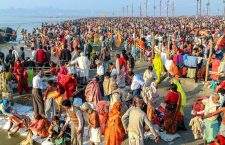A village in Chitrakoot declared Open Defecation Free, even as residents insist all they’ve got in the name of Swachh Bharat is humiliation and empty promises.
“What is the problem, you ask? They promised to give us latrines and they didn’t. That is the problem.” Ram Surema, resident of Semra, a village in Chitrakoot district, Uttar Pradesh, is vehemently dismissive of the government’s claim that the village is now 100% Open Defecation Free.
Prime Minister Narendra Modi launched the Swachh Bharat Mission in October 2014 with the stated goal of eliminating open defecation in India by October 2019, to symbolically coincide with Mahatma Gandhi’s 150th birthday. To do this, the government started a massive toilet-building spree, by offering Rs 12,000 as subsidies to households for building a toilet.
By January 2019, the government claimed five lakh villages and 25 states and union territories had become Open Defecation Free. This includes Uttar Pradesh, India’s most populous state, with a reputation for being one of the worst governed.
According to the official data, Uttar Pradesh has been particularly successful in running the Swachh Bharat programme. Household toilet coverage was just 35.19% in October 2014. The government claims it is now 100%. It also claims 87.9% of the built toilets are being regularly used. And 99.98% of all villages are Open Defecation Free — Semra is listed as one of them. Not just Semra, the entire block of Mau, where it is located, has been declared Open Defecation Free.
But on the ground in Semra, residents rubbish the government’s claims. Many say they do not have toilets and have no choice but to defecate outdoors. The government’s vigilante-styled promotion of Swachh Bharat, they say, had only deepened the stigma over open defecation without providing them an alternative.
Even the Block Development Officer of Mau, Ramesh Chandra Shukla, admitted: “According to the baseline survey, we are ODF. But according to the eligible population, we are not.”
A baseline survey that excludes
The baseline survey that Shukla refers to was done in 2012. The country-wide exercise mapped eligible households that did not have toilets. Eligible households in rural areas were those belonging to the Scheduled Castes and Scheduled Tribes, those with income below the poverty line, and other vulnerable categories like landless workers, the disabled and widows.
Under the Swachh Bharat Mission, the government provides toilet-building subsidies to eligible households identified by the baseline survey. Once such households have been covered in a village, and after the government verifies the newly-built toilets, the government considers the village Open Defecation Free.
Official records show 366 households in Semra as eligible for toilet subsidies under the Swachh Bharat Mission. The village pradhan Vijay Kumar claims the target has been met. “There are 366 toilets [sanctioned] in Semra, of which 364 I can confirm have been built,” he said.
But the official data from the block office shows only 264 toilets have been constructed, while the rest are under process.
The bigger problem. however, is that many eligible households in Semra were not counted in the baseline survey. There are no official estimates but villagers claim as many as 300 of the village’s 600-odd households have been left out.
One of them is Rajmani, a Semra resident who lost her husband a few years ago: “I am a widow. There is no earning member in my family,” she said. “I do not have a toilet.”
According to Shukla, a new list was drafted on October 3, 2018, to include those who had been left out on the baseline survey. He did not disclose how many households were added to the list.
Anger among those left out
The government claim that Semra has become Open Defecation Free is fuelling anger in the village. “Some of us have incomplete latrines, few of us have functional ones, and most of us have none at all,” Surema said.
Rannu Devi, who has submitted an application for the toilet subsidy, said the Swachh Bharat Mission has only made things worse for people like her. “If I defecate in the open, I am shouted at. But where I am supposed to go?”
Vijay Kumar puts it down pat: “If we defecate in somebody’s fields, it usually ends in a fight.”
Many families in the village do not own land. The government’s campaign promoting toilet use and its claims of providing support to everyone who wants to build a toilet has only emboldened the landowning upper castes to deny others access to their fields.
Said Gulab Kali, “If we defecate anywhere, we get yelled at and abused. All of the land here belongs to the Thakurs, we don’t own anything. So, where do we go?”
A subsidy that falls short
The government claims that Rs 12,000 is adequate to build a “low cost but good quality” toilet.
But the experience of villagers in Semra shows it is not. Many of the constructed toilets are lying incomplete.
Not only is the amount inadequate to cover the cost of constructing the toilet, say villagers, it leaves no room for building a ‘handwash unit’, which is what a duly completed household latrine should consist of.
When asked about this, Vijay Kumar, the pradhan, sprung up to the government’s defence. He said the Rs 12,000 is to “facilitate a positive change” in people’s mindsets.
Fudging data
Apart from Semra, seven of the 13 villages in Mau block have been declared Open Defecation Free – Usri Maafi, Bhatganv, Jafarpur, Gagri, Loharka Khurd, Hardi Khurd, Mudha Sani, and Chachhauka.
But official data maintained by the Block Development Office itself shows 3,927 sanctioned toilets in the block still remain to be built.
How come eight villages had been declared Open Defecation Free even before the official targets had been met? When asked this, Shukla casually said the remaining toilets would be completed “any time now.”
The government is supposed to conduct a verification drive before declaring an area Open Defecation Free. But of the 97,000 ODF-declared villages in UP, only 33,000 have been verified.
Shukla, the Block Development Officer of Mau, claimed verification drives were being carried out by his teams every 15-20 days, but in the villages, no one had seen any evidence of it.
While some families in Semra are saddled with incomplete toilets, others are still waiting to get the subsidy. In effect, said Rajamani, a resident of the village, they are worse off than before. “When I go outside to relieve myself, they don’t let me sit down,” said, “You tell me—what am I supposed to do?”
This Khabar Lahariya article first appeared on Scroll.

